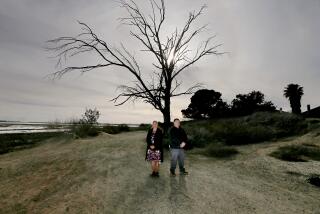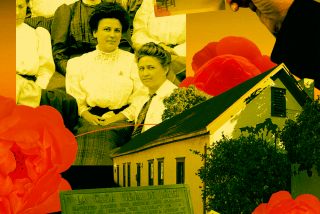A Dirty Job, but Someone Has to Do It
- Share via
The mud will fly again at Mission San Juan Capistrano this weekend when volunteers continue the ritual of patching up the mission’s 200-year-old adobes at the second annual Mud Slinging Festival.
Last weekend, nearly 250 volunteers got up to their elbows in mud as they helped restore the Soldiers’ Barracks, an adobe building constructed in 1791 by Juaneno Indians.
On Saturday, descendants of those Juanenos will lead volunteers in finishing the work to shore up the old adobe building. The event lasts from 9 a.m. to 4 p.m. at the mission.
“I feel very proud in being able to have a part in restoring my ancestors’ work,” said 70-year-old Rudolph R. Martinez, a local Juaneno in charge of mixing the adobe clay for the project, a dying indigenous art.
Martinez searched the area for months for clay that would be compatible with the ancient adobe bricks. He finally found the perfect adobe clay at a construction site not far from the mission.
“This area is a natural for adobe,” Martinez said. “That’s why they built the mission here.”
The mud-slinging tradition goes back to the mission’s early days, when workers would apply a mud seal to the adobes each year after the winter rains to protect them from the elements.
The layer of mud acts as a “sacrificial skin” that washes off over time while providing a temporary shield for the adobe bricks underneath, said Newport Beach preservation architect John Loomis, who heads the restoration process at the mission.
“There’s no modern technology better than what we’re doing right now,” Loomis said. “The only technique is to get the [mud] on the wall, not on the ground.”
Mission officials resurrected the tradition last spring for the first time in nearly 70 years as a way to preserve the historic adobes while at the same time involving the public in restoring the 219-year-old mission.
“The adobes do wear away and there’s no other way to protect those buildings,” said Jim Graves, a spokesman for the mission.
In between the occasional mud fights and mischievous dousings of muddy water, volunteers recognized that their work will help preserve one of the few adobes left in California.
“It’s important to keep what’s here so we can teach our children about our heritage,” said Fountain Valley resident Dolores Pitcher, grandmother of seven and a finance manager for Irvine-based Fluor Daniel Inc., which sent about 30 volunteers last weekend to help with the project. “We’re restoring history.”
More to Read
Sign up for Essential California
The most important California stories and recommendations in your inbox every morning.
You may occasionally receive promotional content from the Los Angeles Times.













